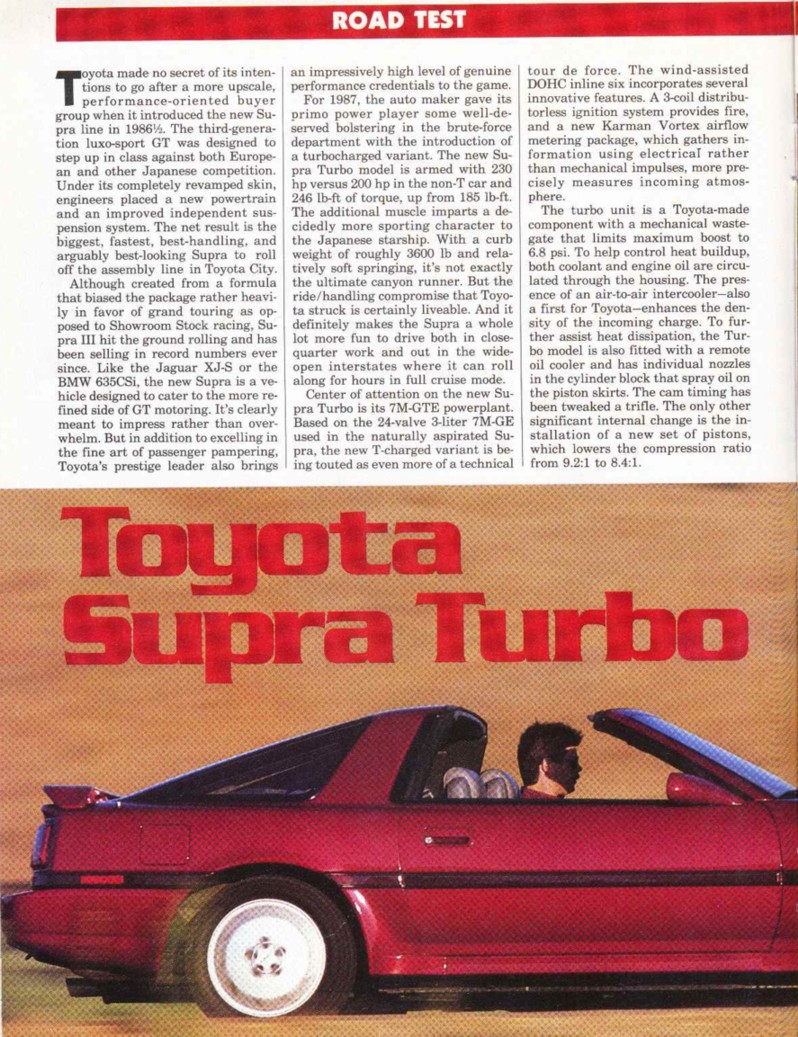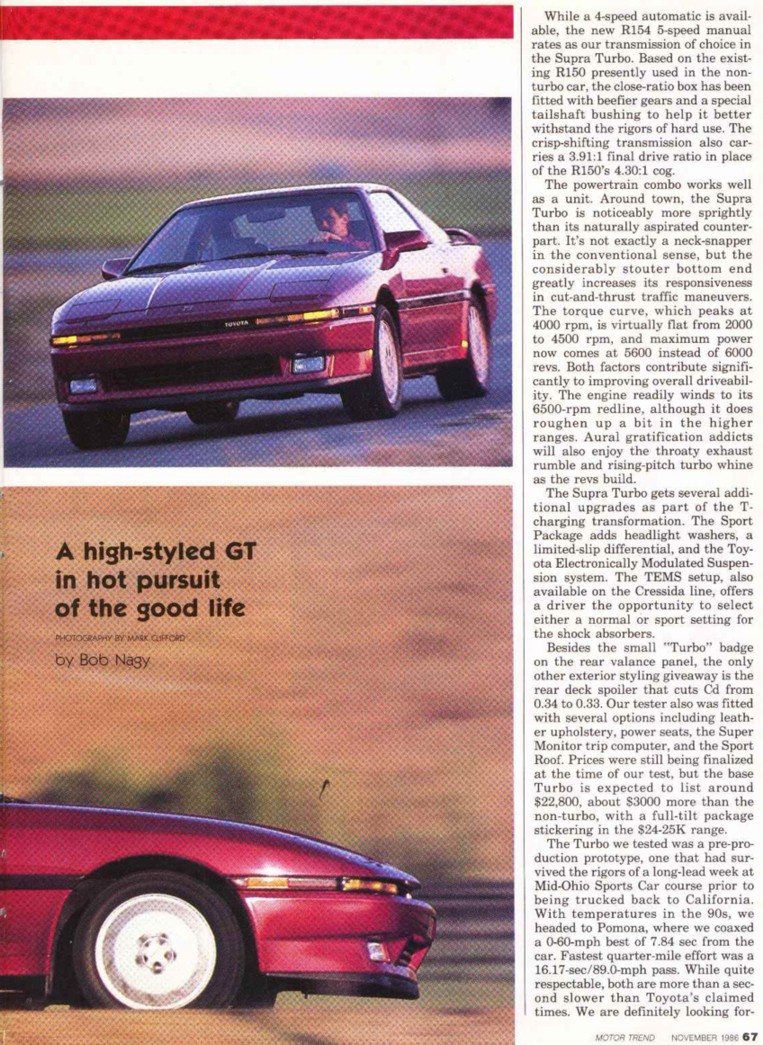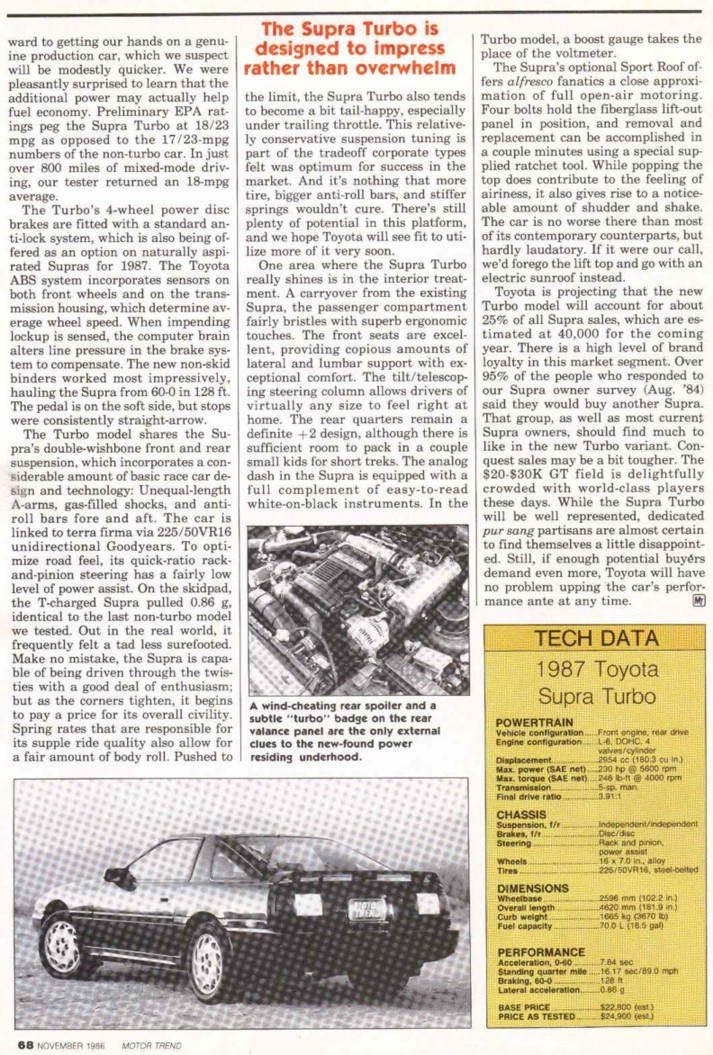
First test of the 1987 Toyota Supra Turbo:
Toyota made no secret of its intentions to go after a more upscale, performance-oriented buyer group when it introduced the new Supra line in 1986 1/2. The third-generation luxo-sport GT was designed to step up in class against both European and other Japanese competition. Under its completely revamped skin, engineers placed a new powertrain and an improved independent suspension system. The net result is the biggest, fastest, best-handling, and arguably best-looking Supra to roll off the assembly line in Toyota City.
Although created from a formula that biased the package rather heavily in favor of grand touring as opposed to Showroom Stock racing, Supra III hit the ground rolling and has been selling in record numbers ever since. Like the Jaguar XJ-S or the BMW 535CSi, the new supra is a vehicle designed to cater to the more refined side of GT motoring. It's clearly meant to impress rather than overwhelm. But in addition to excelling in the fine art of passenger pampering, Toyota's prestige leader also brings an impressively high level of genuine performance credentials to the game.
For 1987, the auto maker gave its primo power player some well-deserved bolstering in the brute-force department with the introduction of a turbocharged variant. The new Supra Turbo model is armed with 230 hp vs. 200 hp in the non-T car and 246 lb-ft of torque, up from 185 lb-ft. The additional muscle imparts a decidedly more sporting character to the Japanese starship. With a curb weight of roughly 3600 lb and relatively soft springing, it's not exactly the ultimate canyon runner. But the ride/handling compromise that Toyota struck is certainly liveable. And it definitely makes the Supra a whole lot more fun to drive both in close-quarter work and out in the wide-open interstates where it can roll along for hours in full cruise mode.
Center of attention on the new Supra Turbo is its 7M-GTE powerplant. Based on the 24-valve 3-liter 7M-GE used in the naturally aspirated Supra, the new T-charged variant is being touted as even more of a technical tour de force. The wind-assisted DOHC inline six incorporates several innovative features. A 3-coil distributorless ignition system provides the fire, and a new Karman Vortex airflow metering package, which gathers information using electrical rather than mechanical impulses, more precisely measure incoming atmosphere.
The turbo unit is a Toyota-made component with a mechanical wastegate that limits maximum boost to 6.8 psi. To help control heat buildup, both coolant and engine oil are circulated through the housing. The presence of an air-to-air intercooler -- also a first for Toyota -- enhances the density of the incoming charge. To further assist heat dissipation, the Turbo model is also fitted with a remote oil cooler and has individual nozzles in the cylinder block that spray oil on the piston skirts. The cam timing has been tweaked a trifle. The only other significant internal change is the installation of a new set of pistons, which lowers the compressions ratio from 9.2:1 to 8.4:1.
While a 4-speed automatic is available, the new R154 5-speed manual rates as our transmission of choice in the Supra Turbo. Based on the existing R150 presently used in the non-turbo car, the close-ratio box has been fitted with beefier fears and a special tailshaft bushing to help it better withstand the rigors of hard use. The crisp-shifting transmission also carries a 3.9:1 final drive ratio in place of the R150's 4.30:1 cog.
The powertrain combo works well as a unit. Around town, the Supra Turbo is noticeably more sprightly than its naturally aspirated counterpart. It�s not exactly a neck-snapper in the conventional sense, but the considerably stouter bottom end greatly increases its responsiveness in cut-and-thrust traffic maneuvers. The torque curve, which peaks at 4000 rpm, is virtually flat from 2000 to 4500rpm, and maximum power now comes at 5600 instead of 6000 revs. Both factors contribute significantly to improving overall driveability. The engine readily winds to its 6500-rpm redline, although it does roughen up a bit in the higher ranges. Aural gratification addicts will also enjoy the throaty exhaust rumble and rising-pitch turbo whine as the revs build.
The Supra Turbo gets several additional upgrades as part of the T-charging transformation. The Sport Package adds headlight washers, a limited-slip differential, and the Toyota Electronically Modulated Suspension system. The TEMS setup, also available on the Cressida line, offers a driver the opportunity to select either a normal or a sport setting for the shock absorbers.
Beside the small "Turbo" badge on the rear valance panel, the only other exterior styling giveaway is the rear deck spoiler that cuts Cd from 0.34 to 0.33. Our tester also was fitted with several options including leather upholstery, power seats, the Super Monitor trip computer, and the Sport Roof. Prices were still being finalized at the time of our test, but the base Turbo is expected to list around $22,800, about $3000 more than the non-turbo, with a full-tilt package stickering in the $24-$25K range.
The Turbo we tested was a pre-production prototype, one that had survived the rigors of a long-lead week at Mid-Ohio Sports Car course prior to being trucked back to California. With temperatures in the 90s, we headed to Pomona, where we coaxed a 0-60-mph best of 7.84 sec from the car. Fastest quarter-mile effort was a 16.17-sec/89.0-mph pass. While quite respectable, both are more than a second slower than Toyota's claimed times. We are definitely looking forward to getting our hands on a genuine production car, which we suspect will be modestly quicker. We were pleasantly surprised to learn that the additional power may actually help fuel economy. Preliminary EPA ratings peg the Supra Turbo at 18/23 mpg as opposed to the 17/23-mpg numbers of the non-turbo car. In just over 800 miles of mixed-mode driving, our tester returned an 18-mpg average.
The Turbo's 4-wheel power disc brakes are fitted with a standard anti-lock system, which is also being offered as an option on naturally aspirated Supras for 1987. The Toyota ABS system incorporates sensors on both front wheels and one on the transmission housing, which determines average wheel speed. When impending lockup is sensed, the computer brain alters line pressure in the brake system to compensate. The new non-skid binders worked most impressively, hauling the Supra from 60-0 in 128 ft. The pedal is on the soft side, but stops were consistently straight-arrow.
The Turbo model shares the Supra's double-wishbone front and rear suspension, which incorporates a considerable amount of basic race car design and technology: Unequal length A-arms, gas-filled shocks, and anti-roll bars fore and aft. The car is linked to the terra firma via 225/50VR16 unidirectional Goodyears. To optimize road feel, its quick-ratio rack-and-pinion steering has a fairly low level of power assist. On the skidpad, the T-charged Supra pulled 0.86 g, identical to the last non-turbo model we tested. Out in the rear world, it frequently felt a tad less surefooted. Make no mistake, the Supra is capable of being driven through the twisties with a good deal of enthusiasm; but as corners tighten, it begins to pay a price for its overall civility. Spring rates that are responsible for its supple ride quality also allow for a fair amount of body roll. Pushed to the limit, the Supra Turbo also tends to become a bit tail-happy, especially under trailing throttle. This relatively conservative suspension tuning is part of the tradeoff corporate types felt was optimum for success in the market. And it's nothing that more tire, bigger anti-roll bars, and stiffer springs wouldn't cure. There's still plenty of potential in the platform, and we hope Toyota will see fit to utilize more of it very soon.
One area where the Supra Turbo really shines is in the interior treatment. A carryover from the existing Supra, the passenger compartment fairly bristles with superb ergonomic touches. The front seats are excellent, providing copious amounts of lateral and lumbar support with exceptional comfort. The tilt/telescoping steering column allows drivers of virtually any size to feel right at home. The rear quarters remain a definite +2 design, although there is sufficient room to pack in a couple small kids for short treks. The analog dash in the Supra is equipped with a full complement of easy-to-read white-on-black instruments. In the Turbo model, a boost gauge takes the place of the voltmeter.
The Supra's optional Sport Roof offers alfresco fanatics a close approximation of full open-air motoring. Four bolts hold the fiberglass lift-out panel in position, and removal and replacement can be accomplished in a couple minutes using a special supplied ratchet tool. While popping the top does contribute to the feeling of airiness, it also gives rise to a noticable amount of shudder and shake. The car is no worse there than most of its contemporary counterparts, but hardly laudatory. If it were our call, we'd forego the lift top and go with an electric sunroof instead.
Toyota is projecting that the new Turbo model will account for about 25% of all Supra sales, which are estimated at 40,000 for the coming year. There is a high level of brand loyalty in this market segment. Over 95% of the people who responded to our Supra owner survey (Aug. '84) said they would buy another Supra. That group, as well as most current Supra owners, should find much to like in the new Turbo variant. Conquest sales may be a bit tougher. The $20-$30K GT field is delightfully crowded with world-class players these days. While the Supra Turbo will be well represented, dedicated pur sang partisans are almost certain to find themselves a little disappointed. Still, if enough potential buyers demand even more, Toyota will have no problem upping the car's performance ante at any time.



Copyright Motor Trend